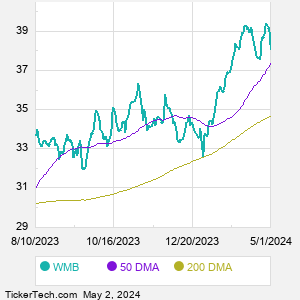Williams Companies is an energy company, providing infrastructure that delivers natural gas products to fuel the clean energy economy. Co.'s segments are: Transmission & Gulf of Mexico, which includes Co.'s subsidiary, Transcontinental Gas Pipe Line Company, LLC, an interstate natural gas pipeline that extends from the Gulf of Mexico to the eastern seaboard; Northeast G&P, which is comprised of Co.'s midstream gathering, processing, and fractionation businesses; West, which is comprised of Co.'s gas gathering, processing, and treating operations in the Rocky Mountain region; and Gas and NGL Marketing Services, which includes Co.'s NGL and natural gas marketing and trading operations.
When researching a stock like Williams Cos, many investors are the most familiar with Fundamental Analysis — looking at a company's balance sheet, earnings, revenues, and what's happening in that company's underlying business. Investors who use Fundamental Analysis to identify good stocks to buy or sell can also benefit from WMB Technical Analysis to help find a good entry or exit point. Technical Analysis is blind to the fundamentals and looks only at the trading data for WMB stock — the real life supply and demand for the stock over time — and examines that data in different ways. One of these ways is called the Relative Strength Index, or RSI. This popular indicator, originally developed in the 1970's by J. Welles Wilder, looks at a 14-day moving average of a stock's gains on its up days, versus its losses on its down days. The resulting WMB RSI is a value that measures momentum, oscillating between "oversold" and "overbought" on a scale of zero to 100. A reading below 30 is viewed to be oversold, which a bullish investor could look to as a sign that the selling is in the process of exhausting itself, and look for entry point opportunities. A reading above 70 is viewed to be overbought, which could indicate that a rally in progress is starting to get crowded with buyers. If the rally has been a long one, that could be a sign that a pullback is overdue. |



